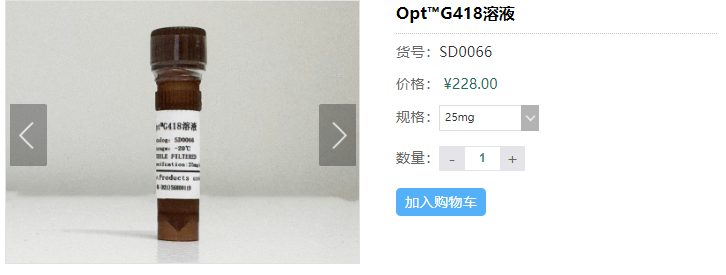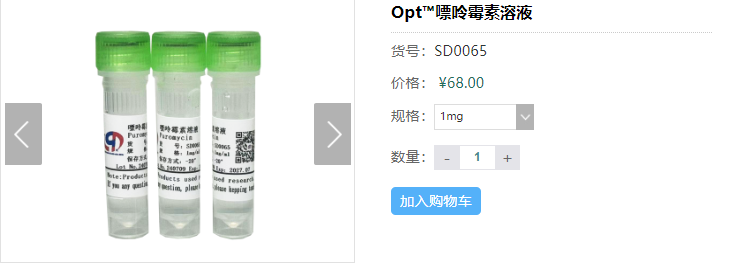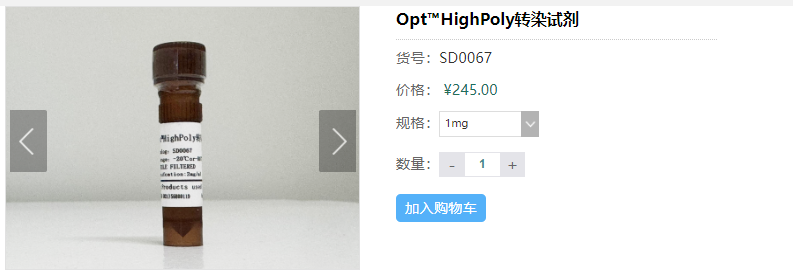Technical Support技术支持
CONTACT US
 400 179 0116
400 179 0116
24-hour service hotline marketing@ldraft.comE-mail
marketing@ldraft.comE-mail
How to choose between G418 and puromycin in cell screening?
source:QiDa technoligy views:2194 time:2024-07-31
How to choose between G418 and puromycin in cell screening? There are significant differences between G418 and purinomycin in chemical properties, mechanism of action and application in biological studies. G418 is an aminoglycoside antibiotic. It blocks protein synthesis in cells mainly by interfering with the function of ribosomes, resulting in toxicity to prokaryotic and eukaryotic cells, including bacteria, yeast, plants, and mammalian cells. In molecular genetic tests, G418 is the most commonly used resistance screening reagent for stable transfection. When neo gene is integrated into the DNA of eukaryotic cells, the sequence encoded by neo gene can be transcribed into mRNA to obtain the efficient expression of the resistance product aminoglycoside phosphotransferase, so that the cells can obtain the resistance to G418 and grow in the selective medium containing G418. Purinomycin, on the other hand, is an amino-nucleoside antibiotic that is a potent inhibitor of protein translation in prokaryotes and eukaryotes. Its chemical structure is similar to the end of tRNA molecules, which can bind to amino acids, bind to the A site of ribosomes instead of aminoacylated tRNA, and incorporate it into the growing peptide chain. However, although purinomycin can bind to the A site, it cannot participate in any subsequent reaction, which leads to the termination of protein synthesis and the release of immature peptides containing purinomycin at the C-terminal. Since purinomycin interferes with the translation process in both prokaryotes and eukaryotes, it is mainly used as a biochemical tool for studying protein synthesis. Therefore, G418 mainly interferes with ribosome function to block protein synthesis and is used for resistance screening of stable transfection. It is used in gene transfer, gene knockout, resistance screening and transgenic animals. Purinomycin inhibits protein translation by simulating tRNA termini, which is mainly used to study biochemical tools of protein synthesis and screen stable transfected cell lines. G418 and purinomycin screen how to screen? Here comes the screening step! 1. G418 Screening operation: 1. Preparation of screening medium: To determine the optimal screening concentration of G418, cell types, growth conditions and other environmental factors should be considered, and the specific concentration range should be determined through experiments. Cells should be cultured with different concentrations of G418 before lentivirus infection: 2. Resuscitated cells: the cells were passed for 2-3 generations, and after cell growth was stable, the cells were passed again, and about 2000 plates/well were counted in 24-well culture plates 3. Take mammalian cell screening as an example: 1. Use medium to dilute G418 solution into 24-well plates of 0ug/ml, 400 ug/ml, 500 ug/ml, 600 ug/ml, 700 ug/ml, 800 ug/ml, 900ug/ml, 1000ug/ml, 1100ug/ml and 1200ug/ ml. 1ml of medium per well (complete medium containing G418), 3-4 replicates per concentration. 2. After 12 hours, the liquid was changed, the culture medium in the culture hole was sucked out, and the PBS was washed once. The screening medium with different concentration was added to each hole, and the screening medium was replaced once every other day. After the concentration of G418 is determined, cells are infected: 3. The infected cells were placed on 6-well plates (200,000 / well), transfected the next day, and replaced with fresh normal medium 6 hours later. The optimal concentration G418 medium was added 24 hours after transfection, and the fluid was changed the next day. 4. After changing the liquid once or twice (culture overnight after changing the liquid), when the cells reach 50%-80%, suck out all the culture medium, centrifuge at 3000-4000rpm, discard the supernatant, add 2 times the volume of fresh culture medium with optimal screening concentration, filter at 0.22um, and mix at 4℃ for use. 5. When a large number of cells die after about 6 days of culture, you can change the adaptive medium, which is formulated in 5. Or you can increase the serum concentration of culture, for example, the original use of 10% serum, then you can use 20% serum. 6. After 10 days of culture, the concentration of G418 was halved to maintain the screening pressure. 7. About 14 days after screening, resistant xx cells appeared, and the cells were cultured and expanded by monoclonal method or scraping negative clones. Second, the screening steps of purinomycin: 2.1. Pre-test to determine the optimal concentration of purinomycin for cell adaptation; 1)Day 1: The target cells (cells to be transformed with stable strain) were planted in 12 or 24 well plates; Preferred paving board 11 holes; 2)Day2: Day2: Target cells should be approximately 80-90% fused; Puromycin was added to the preferred medium of the target cells. The final concentration of purinomycin should be 1-10μg/mL, from 0ug/ml to 10ug/ mL, respectively, with an increment of 1μg/mL per well. The culture medium containing equal concentration of purinomycin should be added and labeled. 3)Day3+: Change the fresh culture medium containing purinomycin every other day; The lowest concentration of purinomycin that causes complete cell death after three to five days is the concentration applied to selection in the experiment, and this titration can also be repeated with finer purinomycin increments to determine a more precise optimal concentration of purinomycin. 2.2 Cell Screening 1) Two samples were laid on the cell plate, with one well for each of the normal cell lines and the infected cell lines, and cultured at 37 degrees 5%CO2 2) When the cells grow to a density of about 60%, the purinomycin obtained in step 2.1 is added for screening; 3) After 48-72 hours of daily fluid exchange, all uninfected normal cell lines died, and infected stable transmutation strains grew normally. It was concluded that stable transmutation strains were successfully constructed. One click direct:
http://www.ldraft.com/qdmore/46161.html

http://www.ldraft.com/qdmore/46158.html

http://www.ldraft.com/qdmore/46162.html








